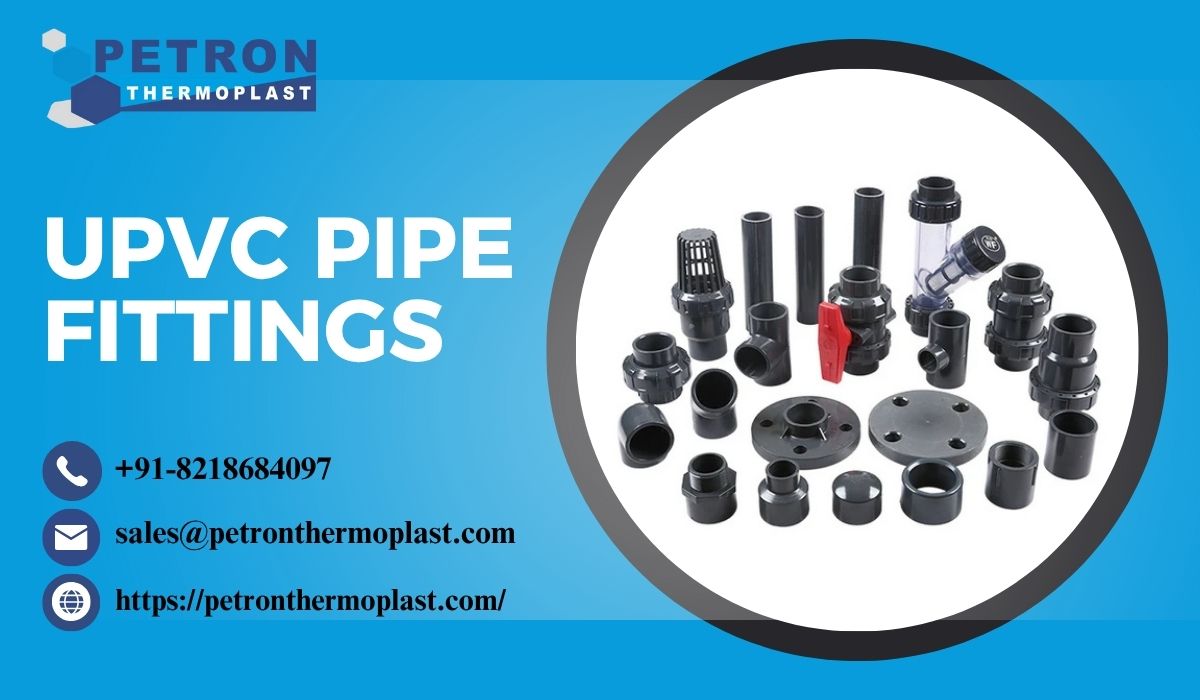In modern plumbing and industrial piping systems, UPVC (Unplasticized Polyvinyl Chloride) pipe fittings have emerged as a leading solution due to their exceptional durability, chemical resistance, and ease of installation. Whether you’re building a water supply network, irrigation system, or industrial piping setup, UPVC fittings offer reliable performance with minimal maintenance. In this blog, we explore what makes UPVC pipe fittings the best choice for your project, their advantages, applications, and why Petron Thermoplast is a trusted supplier in the industry.
What Are UPVC Pipe Fittings?
UPVC pipe fittings are connectors used to join sections of UPVC pipes. These fittings include elbows, tees, reducers, couplers, unions, adaptors, valves, and flanges, designed to direct or regulate fluid flow within a piping system. Unlike regular PVC, UPVC does not contain plasticizers, which makes it more rigid, chemical-resistant, and ideal for pressurized and non-pressurized systems.
UPVC fittings are widely used across industries like plumbing, agriculture, water treatment, and chemical processing due to their ability to withstand high pressures and corrosive environments.
Key Features of UPVC Pipe Fittings
1. High Strength and Durability
UPVC fittings are known for their long service life. They resist impact, weathering, and environmental stress, making them suitable for both indoor and outdoor installations.
2. Corrosion and Chemical Resistance
One of the top reasons for choosing UPVC is its excellent resistance to chemicals, acids, alkalis, and salts. This makes them perfect for use in industrial fluid systems and water treatment plants.
3. Lightweight and Easy Handling
Being lightweight compared to metal alternatives, UPVC fittings are easy to transport, handle, and install, reducing labor costs and time on site.
4. Leak-Proof and Reliable
UPVC fittings ensure tight sealing when properly installed, minimizing the risk of leaks and ensuring efficient fluid flow. They are ideal for both pressurized and gravity flow systems.
5. Thermal and UV Resistance
While UPVC does not perform in very high-temperature systems, it works well within standard temperature ranges (up to 60°C). It also has good resistance to sunlight and UV radiation when used in outdoor applications.
6. Cost-Effective
Compared to metal or CPVC alternatives, UPVC fittings are more affordable without compromising on performance. This makes them an ideal choice for projects with budget constraints.
Types of UPVC Pipe Fittings
UPVC fittings come in a variety of designs to accommodate different pipe systems and configurations:
- UPVC Elbows (90°/45°) – Redirect fluid flow at angles
- UPVC Tee (Equal/Reducer) – Distribute flow across three pipelines
- UPVC Reducer Coupling – Connect pipes of different diameters
- UPVC Union – Allow easy disconnection for maintenance
- UPVC Flange and Stub End – Used with bolts for secure connections
- UPVC Ball Valve / Butterfly Valve – For on/off and control applications
- UPVC End Cap – Seal pipe ends
Advantages Over Other Materials
When comparing UPVC to other commonly used piping materials like metal, copper, or CPVC, the advantages are clear:
| Feature | UPVC | CPVC | Metal |
| Corrosion Resistance | Excellent | Excellent | Poor |
| Weight | Lightweight | Lightweight | Heavy |
| Cost | Low | Moderate | High |
| Temperature Tolerance | Up to 60°C | Up to 93°C | High |
| Maintenance | Low | Low | High |
Applications of UPVC Pipe Fittings
UPVC pipe fittings are used in a wide range of applications, including:
1. Water Supply Systems
Ideal for potable water pipelines due to their non-toxic and corrosion-free properties.
2. Irrigation and Agriculture
Common in drip and sprinkler irrigation systems for greenhouses, gardens, and farms.
3. Sewage and Drainage
Used in residential and commercial waste management systems due to their smooth bore and non-corrosive nature.
4. Industrial Piping
Perfect for handling non-heated chemicals, solvents, and corrosive fluids in industries like pharmaceuticals, paper, textiles, and food processing.
5. Water Treatment Plants
Used in RO, DM, and effluent treatment facilities where chemical resistance and leak-free performance are critical.
Easy Installation Process
One of the standout benefits of UPVC fittings is the simple installation process:
- Solvent Cement Joining: Most UPVC fittings use solvent welding, which chemically bonds the pipe and fitting, creating a seamless and strong joint.
- Threaded Fittings: Available for applications that may need future disassembly or where solvent cement is not ideal.
- Gasket and Flanged Systems: Used for high-pressure or larger diameter pipelines.
No welding or expensive tools are required, and trained technicians can complete installations quickly and efficiently.
Why Choose Petron Thermoplast?
At Petron Thermoplast, we manufacture and supply a full range of high-quality UPVC pipe fittings that meet international standards. Here’s what sets us apart:
- ISO-certified manufacturing processes
- Wide product range from ½” to 12”
- Custom fittings available on request
- Fast delivery and competitive pricing
- Technical support and guidance
Conclusion
If you’re looking for a high-performance, corrosion-resistant, and cost-effective piping solution, UPVC pipe fittings are the best choice. Their versatility, ease of use, and longevity make them ideal for residential, commercial, and industrial projects alike. For the best UPVC pipe fittings, rely on Petron Thermoplast – your one-stop solution for all plastic piping components. Contact us today for custom quotes, technical support, or bulk orders.

